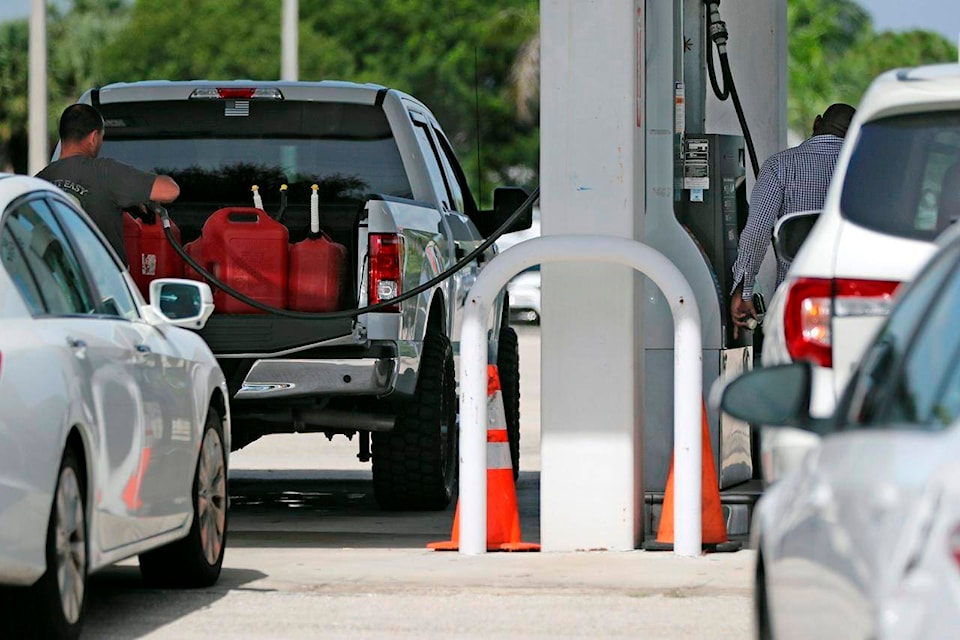SAN JUAN, Puerto Rico — Hurricane Isaias snapped trees and knocked out power as it blew through the Bahamas on Saturday and headed toward the Florida coast, where officials said they were closing beaches, parks and coronavirus testing sites.
Florida authorities said they have prepared shelters, but didn’t expect to have to evacuate people.
“The most important thing we want people to do now is remain vigilant,” said Gov. Ron DeSantis.
Authorities in North Carolina ordered the evacuation of Ocracoke Island, which was slammed by last year’s Hurricane Dorian, starting Saturday evening. Meanwhile, officials in the Bahamas cleared people out of Abaco island who have been living in temporary structures since Dorian devastated the area, killing at least 70 people.
Isaias had maximum sustained winds of 80 miles per hour (130 kilometres per hours) at 11 a.m. Saturday morning, a slight decline from earlier in the day, the U.S. National Hurricane Center said. The centre of the storm is expected to move over northern Andros Island in the next hours, on to Grand Bahama Island in the northwestern Bahamas later in the day then near the east coast of Florida overnight through Sunday. It is expected to weaken slowly late Monday.
A hurricane warning was in effect for northwest Bahamas. Isaias was expected to drop from 4 to 8 inches (10 to 20 centimetres) of rain in the Bahamas and the Turks and Caicos Islands.
Bahamian officials said they were concerned about a Category 1 storm hitting amid the coronavirus pandemic.
“The centre of COVID-19 now is in Grand Bahama,” the island’s minister, Sen. Kwasi Thompson, told government-run ZNS Bahamas. “No one wanted to see a situation where we are now facing a hurricane.”
Paula Miller, Mercy Corps director for the Bahamas, told The Associated Press that people on the island were still standing in line for gas on Saturday ahead of the storm.
The area was still recovering from Dorian, complicating preparations for this one.
“People are doing the best they can to prepare, but a lot of businesses still have not fully repaired their roofs or their structures,” she said. “Even a lower level storm could really set them back.”
A hurricane warning was in effect for Florida’s east coast from Boca Raton, just north of Miami, about 150 miles (240 kilometres) north to the Volusia-Flagler county line. A hurricane watch was in effect from Hallendale Beach to south of Boca Raton.
The state was “fully prepared for this and any future storm during this hurricane season,” DeSantis said, with stockpiles of personal protective equipment, generators, bottled water and meals ready to be distributed.
But he said state-run coronavirus testing sites would be closed in areas where the storm might hit.
“Our sites, because they’re outdoors with tents, if it were to get 40-, 50-mile-per-hour winds, it would just collapse,” he said. “Safety is paramount for that.”
That’s concerning in a state that has been a hot spot in the United States in recent weeks. The pandemic forced officials to wrestle with social-distancing rules at the same time as disaster response.
Miami-Dade Mayor Carlos Giménez said each person in shelters needed to have 40 square feet (nearly 4 square meters) and no more cafeteria-style dining would be allowed. Any evacuees infected with the new coronavirus will be isolated in classrooms separate them from the general population, Giménez said.
In the Bahamas, Prime Minister Hubert Minnis relaxed a coronavirus lockdown as a result of the storm, but imposed a 10 p.m. to 5 a.m. curfew. He said supermarkets, pharmacies, gas stations and hardware stores would be open as long as weather permitted.
The Bahamas has reported more than 570 confirmed COVID-19 cases and at least 14 deaths. It recently barred travellers from the U.S. following a surge in cases after it reopened to international tourism.
On Thursday, while still a tropical storm, Isaias toppled trees, knocked out power, destroyed crops and caused widespread flooding and small landslides in the Dominican Republic and Puerto Rico. One man died in the Dominican Republic, where more than 5,000 people were evacuated, hundreds of homes were damaged or destroyed and more than 130 communities were cut off by floodwaters. In Puerto Rico, the National Guard rescued at least 35 people from floodwaters that swept away one woman who remained missing.
